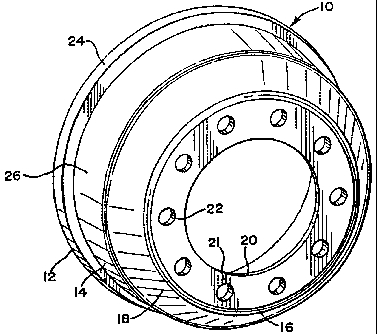Some of the information on this Web page has been provided by external sources. The Government of Canada is not responsible for the accuracy, reliability or currency of the information supplied by external sources. Users wishing to rely upon this information should consult directly with the source of the information. Content provided by external sources is not subject to official languages, privacy and accessibility requirements.
Any discrepancies in the text and image of the Claims and Abstract are due to differing posting times. Text of the Claims and Abstract are posted:
| (12) Patent: | (11) CA 2499543 |
|---|---|
| (54) English Title: | BRAKE DRUM FINISHING & BALANCING |
| (54) French Title: | FINITION ET EQUILIBRAGE DE TAMBOUR DE FREIN |
| Status: | Granted and Issued |
| (51) International Patent Classification (IPC): |
|
|---|---|
| (72) Inventors : |
|
| (73) Owners : |
|
| (71) Applicants : |
|
| (74) Agent: | GOWLING WLG (CANADA) LLP |
| (74) Associate agent: | |
| (45) Issued: | 2010-07-27 |
| (22) Filed Date: | 2005-03-07 |
| (41) Open to Public Inspection: | 2006-09-07 |
| Examination requested: | 2005-03-07 |
| Availability of licence: | N/A |
| Dedicated to the Public: | N/A |
| (25) Language of filing: | English |
| Patent Cooperation Treaty (PCT): | No |
|---|
| (30) Application Priority Data: | None |
|---|
An improved brake drum and method for machining and balancing a brake drum are provided. The inner facing surface and the outer facing surface of the brake drum are machined. The inner and outer faces of the hub end of the brake drum are also machined. The machining is accomplished in a single operation that results in a radially balanced brake drum.
La présente invention concerne un tambour de frein amélioré et une méthode d'usinage et d'équilibrage d'un tambour de frein. Les surfaces intérieure et extérieure du tambour de frein sont usinées. Les faces intérieure et extérieure du tambour de frein du côté du moyeu sont aussi usinées. L'usinage s'effectue en une seule opération qui permet d'obtenir un équilibrage radial du tambour de frein.
Note: Claims are shown in the official language in which they were submitted.
Note: Descriptions are shown in the official language in which they were submitted.

2024-08-01:As part of the Next Generation Patents (NGP) transition, the Canadian Patents Database (CPD) now contains a more detailed Event History, which replicates the Event Log of our new back-office solution.
Please note that "Inactive:" events refers to events no longer in use in our new back-office solution.
For a clearer understanding of the status of the application/patent presented on this page, the site Disclaimer , as well as the definitions for Patent , Event History , Maintenance Fee and Payment History should be consulted.
| Description | Date |
|---|---|
| Common Representative Appointed | 2019-10-30 |
| Common Representative Appointed | 2019-10-30 |
| Change of Address or Method of Correspondence Request Received | 2018-01-16 |
| Grant by Issuance | 2010-07-27 |
| Inactive: Cover page published | 2010-07-26 |
| Revocation of Agent Requirements Determined Compliant | 2010-06-28 |
| Inactive: Office letter | 2010-06-28 |
| Appointment of Agent Requirements Determined Compliant | 2010-06-28 |
| Pre-grant | 2010-05-07 |
| Inactive: Final fee received | 2010-05-07 |
| Notice of Allowance is Issued | 2010-04-19 |
| Letter Sent | 2010-04-19 |
| Notice of Allowance is Issued | 2010-04-19 |
| Inactive: Approved for allowance (AFA) | 2010-04-07 |
| Amendment Received - Voluntary Amendment | 2010-01-14 |
| Inactive: S.30(2) Rules - Examiner requisition | 2009-08-07 |
| Amendment Received - Voluntary Amendment | 2009-05-13 |
| Inactive: S.30(2) Rules - Examiner requisition | 2009-01-05 |
| Amendment Received - Voluntary Amendment | 2008-07-23 |
| Inactive: S.30(2) Rules - Examiner requisition | 2008-04-24 |
| Amendment Received - Voluntary Amendment | 2008-01-24 |
| Inactive: S.30(2) Rules - Examiner requisition | 2007-09-14 |
| Application Published (Open to Public Inspection) | 2006-09-07 |
| Inactive: Cover page published | 2006-09-06 |
| Inactive: IPC assigned | 2005-06-06 |
| Inactive: First IPC assigned | 2005-06-06 |
| Inactive: IPC assigned | 2005-06-03 |
| Inactive: IPC assigned | 2005-06-03 |
| Inactive: IPC assigned | 2005-06-03 |
| Inactive: Inventor deleted | 2005-04-11 |
| Filing Requirements Determined Compliant | 2005-04-11 |
| Letter Sent | 2005-04-11 |
| Letter Sent | 2005-04-11 |
| Inactive: Filing certificate - No RFE (English) | 2005-04-11 |
| Inactive: Applicant deleted | 2005-04-11 |
| Application Received - Regular National | 2005-04-11 |
| Request for Examination Requirements Determined Compliant | 2005-03-07 |
| All Requirements for Examination Determined Compliant | 2005-03-07 |
There is no abandonment history.
The last payment was received on 2010-03-03
Note : If the full payment has not been received on or before the date indicated, a further fee may be required which may be one of the following
Please refer to the CIPO Patent Fees web page to see all current fee amounts.
Note: Records showing the ownership history in alphabetical order.
| Current Owners on Record |
|---|
| CONSOLIDATED METCO, INC. |
| Past Owners on Record |
|---|
| JOSEPH A. BROTHERTON |
| TIMOTHY TODD GRIFFIN |